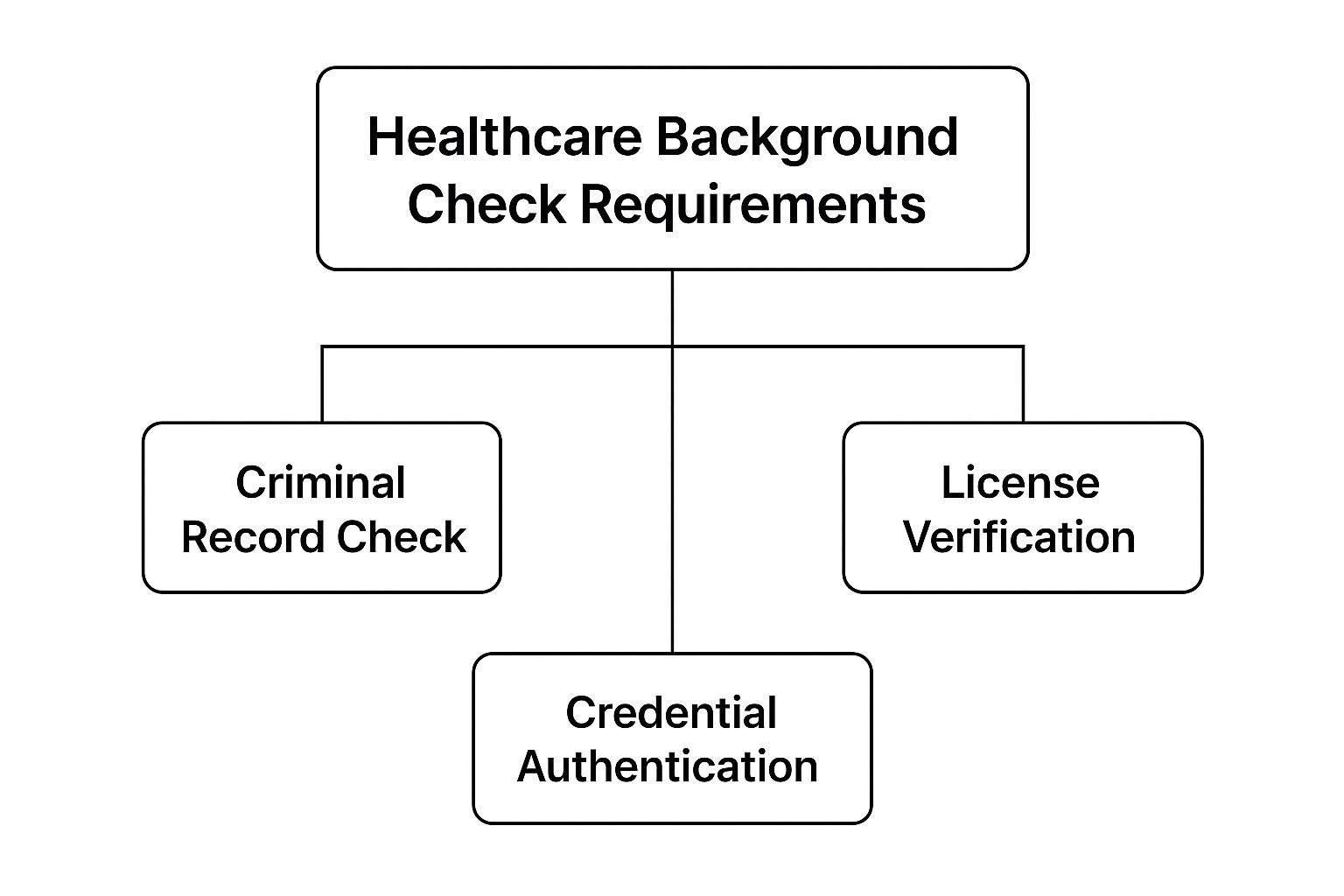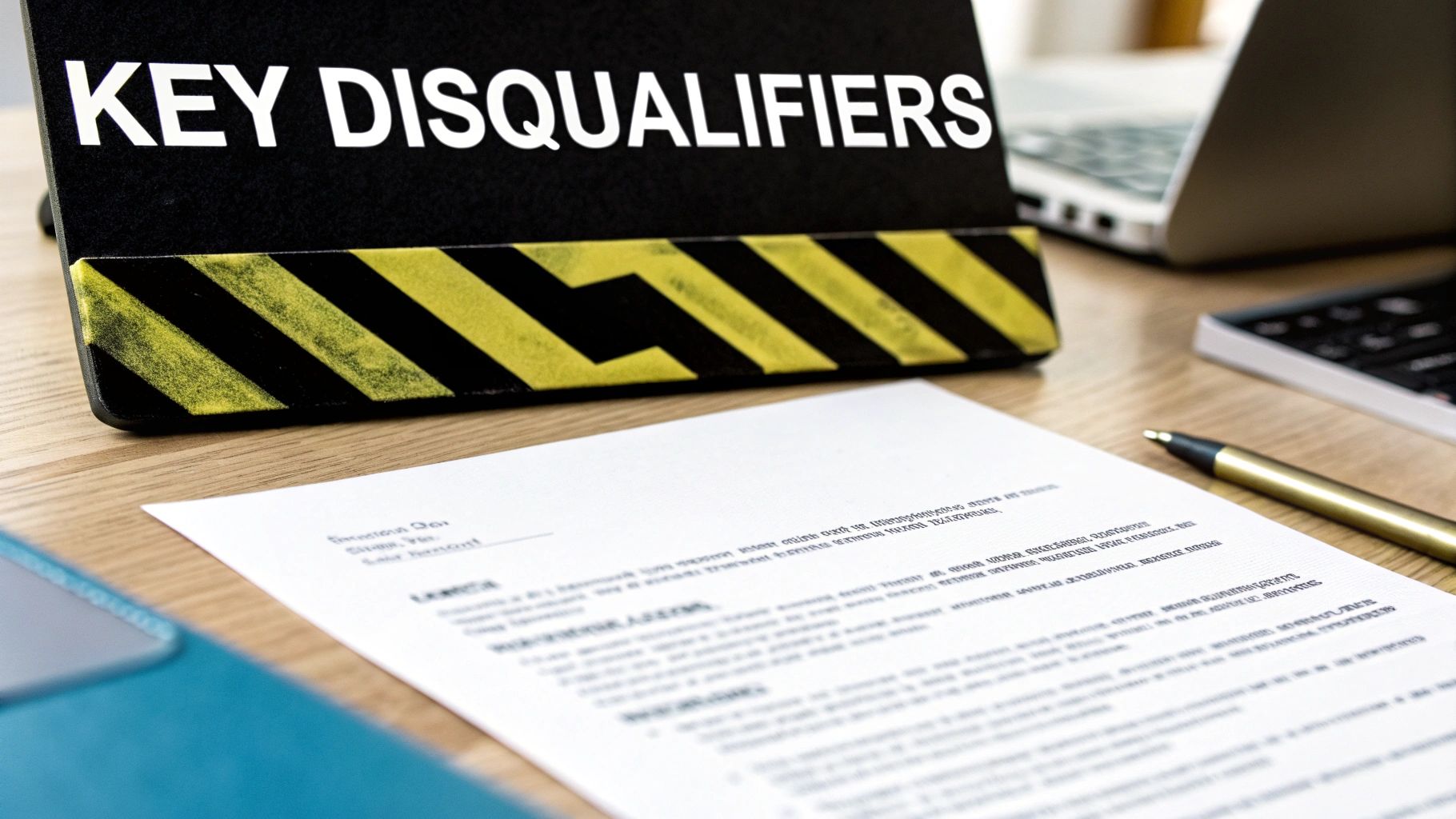Understanding Why Healthcare Screening Is Different

Think of a typical employment screening as a standard lock on a home’s front door. It provides a basic level of security. A healthcare background check, however, is more like a multi-layered security system for a bank vault. It’s designed to protect the most valuable asset imaginable: human health and safety. This isn’t just about finding a reliable employee; it’s about safeguarding vulnerable people who put immense trust in their caregivers.
Because the potential for harm is so great, a simple criminal history check just doesn’t cut it. The healthcare field demands a much deeper investigation into a candidate’s background. Consider the risks: a home health aide with a history of theft caring for an elderly patient, or a technician with an unrevealed drug problem having access to hospital medications. These scenarios underscore why healthcare background check requirements are so demanding.
A Mandate for Patient Safety
This intense level of screening isn’t just a recommendation—it’s a requirement driven by strict regulations. The healthcare industry is heavily monitored to ensure patient well-being. In the United States, for example, The Joint Commission, an organization that accredits and certifies over 22,000 healthcare organizations and programs, requires that all individuals who work in patient care undergo thorough screening. This creates a consistent safety standard across the country’s medical facilities.
Verifying More Than Just a Resume
Ultimately, these checks are about confirming a candidate’s character, competence, and professional integrity. For positions requiring specialized skills, like nurse practitioners, verifying licenses and certifications is just as important as a criminal background check. Each part of the screening process contributes to a complete picture, ensuring the applicant has the qualifications and ethical foundation needed to provide safe and effective care.
Breaking Down Essential Healthcare Screening Components
Think of a healthcare background check like a thorough home inspection. A quick glance from the curb won’t tell you about faulty wiring or a cracked foundation. You need a methodical check of every system to get a complete picture of safety. Similarly, while many jobs require just a few basic screenings, healthcare roles often demand 5-7 specific checks, each designed to inspect a unique area of risk. These individual screenings fit together like puzzle pieces to build a clear profile of a candidate’s fitness for patient care.
This visual illustrates how the main healthcare background check requirements create a layered system of trust and verification.

The infographic shows that foundational checks, such as criminal history, form the base. More specialized verifications, like confirming licenses and credentials, are built on top of that base to ensure professional competence.
Core Screening Types and Their Purpose
Each type of screening serves a specific, protective function, going beyond a simple “pass” or “fail” to create a detailed understanding of an applicant.
To clarify how these checks work in practice, the table below breaks down the most common screenings, their purpose, and which roles typically require them.
| Screening Type | Purpose | Required For | Typical Timeframe |
|---|---|---|---|
| Criminal History & Sex Offender Registry Search | Protects vulnerable patients by identifying past offenses like assault, theft, or abuse. | All patient-facing and administrative roles. | 1-3 business days |
| Professional License & Certification Verification | Confirms licenses (e.g., nursing, medical) are valid, current, and in good standing. | All licensed professionals (Nurses, Doctors, Therapists, Pharmacists). | 2-5 business days |
| Employment & Education Verification | Validates work history and academic degrees to ensure the candidate has the claimed experience. | All roles, especially those requiring specific degrees or experience. | 2-4 business days |
| Drug Screening | Ensures caregivers are not impaired, especially given their access to controlled substances. | Most clinical roles, including physicians, nurses, and technicians. | 1-3 business days |
| Sanction & Exclusion List Check | Screens federal/state databases (OIG, GSA) for individuals barred from healthcare programs. | All roles in facilities receiving federal funds (e.g., Medicare/Medicaid). | Instant to 1 business day |
This table shows that while a criminal history search is a universal baseline, specialized roles like doctors and nurses require additional layers of verification, such as license and sanction checks, to ensure both safety and compliance.
Here’s a closer look at what each of these key checks involves:
- Criminal History and Sex Offender Registry Searches: This is the absolute baseline for patient safety. It flags individuals with a history of offenses that could endanger vulnerable people. It’s a non-negotiable step for any healthcare employer.
- Professional License and Certification Verification: This check confirms an applicant’s qualifications are real, current, and not under any disciplinary action. It prevents a dangerous situation, like someone with a revoked nursing license, from providing patient care.
- Employment and Education Verification: This step roots out falsified resumes by confirming past jobs and degrees. It ensures an applicant genuinely possesses the background and training needed to work in a critical care setting.
- Drug Screening: With many roles having access to powerful medications, this screening is vital. A study found that an estimated 10%-12% of physicians have a substance abuse disorder, making pre-employment and ongoing drug tests essential for patient safety.
- Sanction and Exclusion List Checks: These searches scan databases for individuals legally barred from participating in government-funded healthcare programs like Medicare. Hiring a sanctioned person can lead to significant fines and penalties for the healthcare organization.
Navigating The Complex Web Of Healthcare Regulations

Trying to understand healthcare background check regulations can feel like following a GPS with overlapping maps. Federal highways set the main routes, but state roads and local streets add layers of complexity. You have to follow all of them at once to reach your destination. Federal laws like the Fair Credit Reporting Act (FCRA) establish a national baseline, creating the ground rules for how background information is gathered and used. But this is just the beginning of the journey.
The regulatory picture gets much more detailed at the state level. Each state introduces its own specific rules, creating a patchwork of requirements that can differ significantly from one border to the next. This is a major factor shaping current healthcare staffing trends, as organizations that operate in multiple states must navigate a diverse and sometimes conflicting set of legal landscapes.
Federal Foundation vs. State Specifics
Think of it this way: federal laws provide the “what,” such as the need to get a candidate’s consent before a screening. State laws, however, often define the “how” and “who,” adding distinct procedures and requirements to the process.
- Federal Requirement: The FCRA dictates that employers must obtain a candidate’s written permission before running a background check. It also requires them to follow a clear procedure if the check’s findings lead to a decision not to hire.
- State-Specific Example: Certain states, like Florida and New Jersey, mandate fingerprint-based FBI checks for specific healthcare roles. In contrast, other states might permit private screening companies to perform name-based searches, which is a different process entirely.
This means a healthcare provider with facilities in both New York and California can’t simply apply a one-size-fits-all screening program. It must create a process that complies with the strictest rules of each state it operates in. For employers, staying compliant is not just about avoiding penalties; it’s about upholding the legal and ethical standards required to provide safe patient care.
How Modern Healthcare Screening Actually Works

If you picture healthcare background checks as a dusty office filled with filing cabinets and long delays, it’s time for an update. Today’s process is a sophisticated blend of technology and human expertise designed to meet strict healthcare background check requirements with impressive speed. The moment a candidate gives their consent, a carefully orchestrated series of events kicks off.
The first step is a digital deep dive. Once you submit your details, automated systems spring into action, scanning numerous databases in seconds. Think of it as a specialized search engine built for verification, cross-referencing information to ensure accuracy. This initial sweep uses smart technology to flag potential issues, like a name on a sanctions list or conflicting employment dates. This tech-first approach has slashed turnaround times; some criminal checks now return results in just 24-48 hours, a major leap from the old 5-to-7-day standard. You can learn more about these developments in recent reports on 2024 screening technology trends.
The Human Element in Decision-Making
But technology’s role is to present the facts, not to make the final judgment. This is where trained professionals become critical. A flagged record does not mean automatic rejection. Instead, a compliance expert steps in to review the context. They ask important questions:
- Was the offense minor and from many years ago?
- Is there a reasonable explanation for a data mismatch?
- Does this issue actually impact the candidate’s ability to perform the job safely?
This careful review ensures the process is fair and abides by regulations like the Fair Credit Reporting Act (FCRA).
This combination of automation for speed and human oversight for fairness forms the foundation of modern screening. The “processing” time you see is often this handoff in motion. While simple, clear reports come back quickly, more complex cases that require manual court record searches or international checks will understandably take longer. This balanced system helps healthcare organizations uphold rigorous safety standards while treating every applicant with respect.
Recognizing and Preventing Healthcare Screening Fraud
Healthcare screening fraud is no longer just about a white lie on a resume. Today’s schemes are far more intricate, involving everything from deepfake reference calls to entire networks dedicated to forging professional credentials. This isn’t about catching small exaggerations; it’s about identifying coordinated campaigns to invent a believable, yet completely false, professional history. These deceptions are a direct threat to patient safety and the integrity of healthcare organizations.
We’ve seen cases where fraudsters invent fake nursing schools or steal the identities of real, licensed professionals to land a job. Because the stakes are so high, learning to spot the subtle red flags is a fundamental part of meeting healthcare background check requirements.
Spotting Sophisticated Deception
Vigilance is your best tool for identifying applicants who might be misrepresenting their qualifications. A strong screening process looks for the kinds of inconsistencies that automated systems can easily miss. Here are a few signs that could point to fraud:
- Inconsistent Timelines: Be wary of employment dates that line up a little too perfectly. A history with no gaps can sometimes be a sign of fabrication rather than a perfect career path.
- Vague References: If a listed reference gives glowing but generic praise without recalling specific projects or daily duties, it’s a major warning sign.
- Questionable Credentials: An applicant might claim a degree from a real institution that doesn’t actually offer that specific program. This kind of detail requires a closer look.
A Multi-Layered Verification Approach
To fight these threats, healthcare providers need a verification process with multiple layers of security. Identity fraud and credential falsification are serious risks, and a simple checkbox approach is no longer enough. The growing threat has pushed more organizations to adopt biometric verification and digital credentialing.
This shift is reflected in the growth of the employment screening market, which is projected to expand from $4.73 billion in 2024 to an expected $4.96 billion in 2025. You can find more details on this trend in a report about the employment screening services market. While technology is a great first line of defense, the skill of human reviewers is critical for making sense of complex information and uncovering even the most convincing fraudulent applications.
Best Practices for Healthcare Employers Who Get It Right
The best healthcare organizations treat background screening not as a simple checklist, but as a critical part of building a trustworthy and safe environment. Think of it like a master chef preparing a complex recipe: they follow a proven formula but also adapt to the specific needs of each role. These employers move beyond just meeting legal requirements, creating screening programs that put patient safety first while treating every applicant with fairness and respect. This balanced approach isn’t just about compliance; it’s about establishing trust from the very first interaction.
Create a Consistent Policy
A clearly documented screening policy is the foundation of a fair and defensible process. This document should detail exactly which checks are required for each role, guaranteeing every applicant for the same position goes through the same screening. It must also map out a clear, step-by-step procedure for handling adverse findings—like a very old criminal record—in a way that is consistent, compassionate, and legally sound. This framework takes the guesswork out of difficult decisions and helps your HR team act confidently.
Balance Thoroughness with Efficiency
While comprehensive screening is essential, a slow and clunky hiring process can cause you to lose top talent to competitors. The most effective employers have figured out how to be both thorough and quick.
Here are a few proven strategies:
- Establish Clear Criteria: Define what would disqualify a candidate for each specific role before you even start the screening process.
- Communicate Clearly: Keep candidates in the loop about the screening steps and expected timelines. This simple act can significantly reduce their anxiety and improve their experience.
- Partner with Experts: Work with a reliable, accredited screening provider to ensure both the accuracy of the information and the speed of the process.
To help organizations refine their screening programs, we’ve developed a checklist of best practices. This table outlines key actions, compliance considerations, and common mistakes to avoid.
| Practice Area | Key Actions | Compliance Notes | Common Pitfalls |
|---|---|---|---|
| Policy Development | Create a written, role-specific background check policy. Clearly define disqualifying offenses. | Ensure the policy is applied consistently to all applicants for the same role to avoid discrimination claims. | Having a vague or one-size-fits-all policy that doesn’t account for different job responsibilities. |
| Legal Compliance | Obtain written consent before screening. Follow all FCRA pre-adverse and adverse action steps. | Stay updated on federal laws like the FCRA and Title VII, plus state-specific “ban-the-box” laws. | Failing to provide pre-adverse action notices, denying candidates a chance to dispute incorrect information. |
| Screening Scope | Match the depth of the check to the role (e.g., OIG/GSA checks for roles with federal program interaction). | Avoid running checks that are not job-related (e.g., credit reports for roles with no financial duties). | Running overly broad checks that are not relevant to the job, increasing legal risk and cost. |
| Candidate Experience | Be transparent with candidates about the process. Provide status updates and clear timelines. | Ensure the process is fair and gives candidates an opportunity to explain any negative findings. | Poor communication, long delays, and a lack of transparency, which can damage your employer brand. |
| Adjudication Process | Conduct an individualized assessment for any adverse finding, considering the nature of the offense, time passed, and job relevance. | Document every step of the decision-making process to demonstrate fairness and compliance with EEOC guidance. | Making automatic disqualifications based on a record without considering context or individual circumstances. |
Table Title: Healthcare Background Check Best Practices Checklist
Table Description: Essential steps and proven strategies for implementing effective healthcare screening programs that protect patients while treating candidates fairly.
Ultimately, shifting your perspective is key. Viewing healthcare background check requirements as an opportunity to build a relationship, rather than just as a gatekeeping exercise, is a core part of effective healthcare recruitment strategies. This mindset not only protects patients but also helps you attract and keep the best professionals, strengthening your organization’s mission and culture.
Your Roadmap As A Healthcare Job Candidate
Facing a healthcare background check can feel like a stressful exam, but it’s more productive to think of it as a standard procedure designed for one crucial purpose: patient safety. The goal isn’t to catch good people on minor issues from the distant past. Instead, these detailed healthcare background check requirements exist to protect the very individuals you’re aspiring to care for. Honesty and preparation are your best tools.
Understand Your Rights and Responsibilities
As a candidate, you are protected by the Fair Credit Reporting Act (FCRA). This law requires employers to get your written permission before they start a background check. If they find something that could affect their hiring decision, they must give you a copy of the report and a summary of your rights before making a final choice. This is your window to check for mistakes and dispute any incorrect information.
On your end, the main responsibility is to be truthful. Trying to conceal a past problem is often more harmful than explaining it. Most employers are more interested in your character and how you’ve grown than in a completely perfect record.
How to Prepare for the Screening
Being ready can make the entire process smoother and less stressful. Think of it as organizing your professional life before an important interview.
- Gather Your Documents: Get your professional licenses, certifications, diplomas, and a detailed work history in order. Having these ready shows you’re organized and serious about the role.
- Run Your Own Check: You might want to order a personal background check on yourself. This lets you see exactly what employers will see, giving you a chance to prepare explanations for any potential red flags.
- Be Proactive: If you know there’s a potential issue, like a past conviction, don’t wait to be caught off guard. Prepare a short, professional explanation that centers on what you learned from the experience and how it has shaped you.
- Communicate Clearly: If you get the chance during the hiring process, address any concerns head-on. By framing past events as learning opportunities, you can show how they’ve reinforced your dedication to ethical conduct and patient care.
With thorough preparation and a commitment to transparency, you can approach the screening process with confidence. Ready to find your next role with an organization that values your expertise? Find curated opportunities on Remote Health Co and connect with top healthcare employers today.


